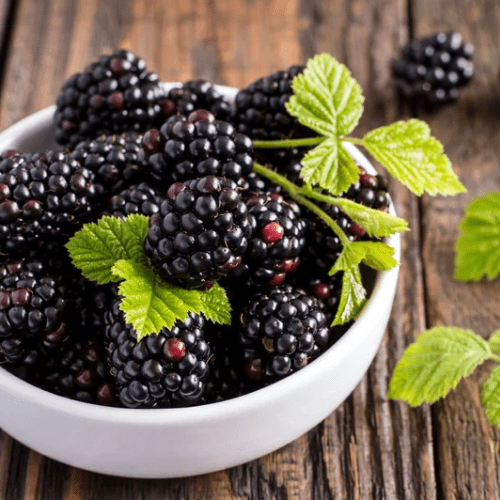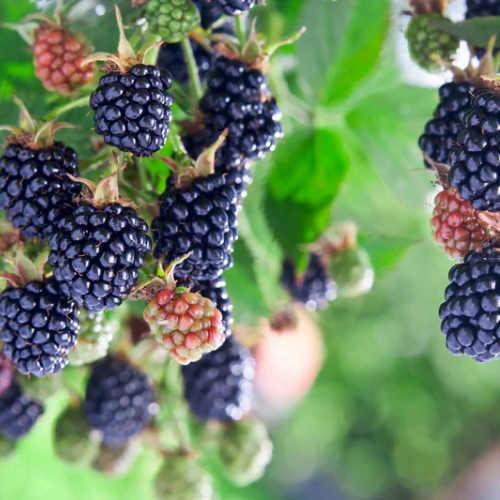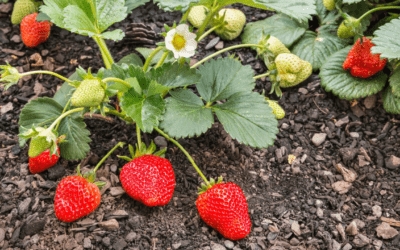1. Varieties of Blackberries:
- There are different types of blackberries, including erect, semi-erect, and trailing varieties.
- Popular varieties include thornless blackberries like ‘Apache’ and ‘Arapaho’ and thorny varieties like ‘Chester’ and ‘Triple Crown’.
- Erect varieties grow vertically, while trailing varieties spread along the ground or need support.
2. Primo Cane vs. Florocane:
- Primo canes are first-year canes that don’t produce fruit. They grow vegetatively.
- Florocanes are second-year canes that bear fruit. After fruiting, they die back.
- Prune florocanes after fruiting to encourage new growth. Prune primo canes in late winter or early spring.
There are some blackberry varieties that produce fruit on both primo and florocanes. These varieties are called “primocane-fruiting” or “everbearing” blackberries. Unlike traditional varieties that only fruit on second-year canes (florocanes), primocane-fruiting blackberries produce fruit on both first-year (primo) and second-year canes.
This characteristic allows primocane-fruiting blackberries to bear fruit twice in a single growing season: once on the primo canes in late summer or fall of the first year, and again on the florocanes in the following year. This extended fruiting period provides gardeners with a longer harvest window and increased yields.
When growing primocane-fruiting blackberries, it’s important to manage pruning appropriately to maximize fruit production on both types of canes. Prune florocanes after they have finished fruiting, similar to traditional blackberry varieties, to encourage new growth and fruiting in subsequent years. Additionally, some gardeners may choose to selectively prune primo canes to promote larger fruit size or better fruit quality.

3. Planting and Soil:
- Plant blackberries in late winter or early spring.
- Choose a sunny location with well-draining soil rich in organic matter.
- Ideal soil pH for blackberries is between 5.5 and 7.0.
- Amend soil with compost or well-rotted manure before planting.
4. Trellising:
- Erect varieties benefit from trellising for support.
- Use a sturdy trellis for trailing varieties to keep them off the ground.
5. Fertilizing:
- Fertilize blackberries in early spring with a balanced fertilizer.
- Repeat fertilization after fruiting to support new growth.
6. Harvesting:
- Harvest ripe blackberries in the early morning when they’re cool and firm.
- Gently pick berries to avoid crushing them.
7. Cleaning and Preserving:
- Rinse harvested blackberries gently under cold water and pat dry.
- Store unwashed berries in the refrigerator for up to a week.
- For longer storage, freeze berries on a tray before transferring to a freezer bag.
8. Companion Plants:
- Good companion plants for blackberries include culinary herbs like mint and thyme, which can deter pests.
- Avoid planting vegetables from the nightshade family (tomatoes, peppers, eggplants) near blackberries, as they can compete for nutrients and space.
9. Pest Control:
- Watch out for pests like aphids, spider mites, and Japanese beetles.
- Organic pest control methods include using neem oil, insecticidal soap, or beneficial insects like ladybugs.
10. Propagation:
- Blackberries can be propagated through tip layering, division of root suckers, or stem cuttings.
- Trimmed vines can be rooted in soil to grow new plants.
11. Soil pH Adjustment:
- Adjust soil pH by adding lime to raise pH or sulfur to lower pH, based on soil test results.
- Apply amendments in fall to allow time for them to take effect before planting.
12. Lifespan and Fruit Production:
- Blackberry bushes can last for many years with proper care.
- Expect fruit production from mid to late summer, depending on the variety and climate.
With these guidelines, you’ll be well on your way to growing delicious blackberries in your garden!

The variety we grow in our Oklahoma garden is called Prime-Ark Traveler.
Prime-Ark Traveler is a blackberry cultivar developed by the University of Arkansas. Here are the details about this cultivar:
1. Origin: Prime-Ark Traveler was developed by the University of Arkansas’s fruit breeding program, known for creating high-quality blackberry cultivars.
2. Characteristics:
- Prime-Ark Traveler is a primocane-fruiting blackberry, meaning it produces fruit on both first-year (primo) and second-year (florocane) canes.
- It is known for its large, flavorful berries that are typically ripe in mid-summer and continue to produce through the fall.
- The berries are glossy black with a sweet, juicy flavor, making them excellent for fresh eating, baking, and preserves.
3. Disease Resistance:
- Prime-Ark Traveler exhibits resistance to several common blackberry diseases, including double blossom/rosette, orange rust, and anthracnose.
- This disease resistance makes it a reliable and low-maintenance option for home gardeners and commercial growers alike.
4. Growing Habit:
- Prime-Ark Traveler has a semi-erect growth habit, meaning it benefits from some support but doesn’t require extensive trellising like trailing varieties.
- It can be grown in various climates but thrives in areas with warm summers and mild winters.
5. Bred For:
- Prime-Ark Traveler was bred for its combination of early fruiting, extended harvest season, large berry size, and disease resistance.
- It was designed to provide home gardeners and commercial growers with a high-yielding, low-maintenance blackberry cultivar that produces quality fruit over an extended period.
Interesting Facts:
- Prime-Ark Traveler is part of the Prime-Ark series of blackberries developed by the University of Arkansas, which includes other primocane-fruiting cultivars like Prime-Ark Freedom and Prime-Ark 45.
- The University of Arkansas’s fruit breeding program is renowned for its work in developing new blackberry, raspberry, and strawberry cultivars with improved flavor, yield, and disease resistance.
Prime-Ark Traveler stands out as a versatile and high-performing blackberry cultivar, offering gardeners a reliable option for fresh berries throughout the growing season.





0 Comments